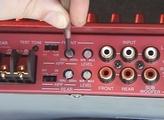Amplifier Power Ratings - Who Can You Trust?
As a follow up to the article on power specifications I feel I should provide some more details and examples. The fact is that there is not a standard for rating amplifiers that manufacturers have to follow. This leads to deceptive marketing and magic power specifications on amplifiers. The only true specification, if it is followed, is the RMS power rating (preferably using the CEA-2006 testing procedures). And even the RMS rating can be abused by a second rate company. Sometimes you just have to use your head when amplifier shopping.
A 1,000 amplifier should cost in the $700+ range for a quality amplifier from a reputable manufacturer. For example, the Rockford Fosgate Prime R1200-1D amplifier will put out 1,200 watts into a 1 ohm load and retails for $450. An Alpine MRP-M1000 amplifier will put out 1,000 watts into a 2 ohm load and retails for $400. Expect to pay about $0.40-$0.80 per watt for a good amplifier. Less per watt for larger amps and more per watt for smaller amps. This is at the MSRP. That's a general guideline and will vary by manufacturer. But if you see an amplifier that claims 3,000 watts and costs $200 then you'll know something's not right. The following question was from a person with a very common problem. Read over his question and my reply and try to keep yourself from making the same mistake.
The Questions:
"I just put an amp and subs in my 96 Jeep. The subs can handle 2200 watts each, the amp is a [COMPANY WITHHELD] 3,000 watt. Wired in parallel dual voice coils, (2) 12's. The problem is that at about half volume the amp kicks out. The amp says it requires at a minimum 1 extra battery and a 1 Farad cap. Do I really need them both and do you think that would take care of it?"
My Reply:
Let me give you a few hard truths first.
- Your subs will not handle 2,200 watts a piece.
- Your amplifier does not put out 3,000 watts.
I don't even need to know what subs you have to tell you that they won't handle near that amount of power. Even the 13W7 from JL Audio is only rated for 1,000 watts. Erase that thought from your mind. The same goes for your amp. I hadn't heard of [COMPANY WITHHELD] amps before this. I did some homework and found out that they claim that their $300 amp is 1/2 ohm stable and puts out 1,500 watts RMS into 1/2 ohm (3,000 watts "peak"). Not a chance. Only a handful of top quality amps are 1/2 ohm stable and they cost a lot. I received a similar email from a guy with a [COMPANY WITHHELD] amp that claimed similar specs. I gave him the same warning but he didn't listen and ended up frying the amp within a week. Your best bet with that amp is to run it into a four ohm load per channel. Maybe a two ohm stereo load with your four ohm voice coils wired in parallel. Don't be tempted to bridge the amp to the one ohm load you could get with all of the coils in parallel. They might claim it will work but I know you'll fry it."
Follow up from the questioner: "I just rewired the speakers in a 2 ohm load and it all works great now! Thanks again."

You may also be interested in How to Install Your Own Car Stereo System . It covers many topics including in depth car audio amplifier installation. Click here.
Back to the Newsletter Archives Index